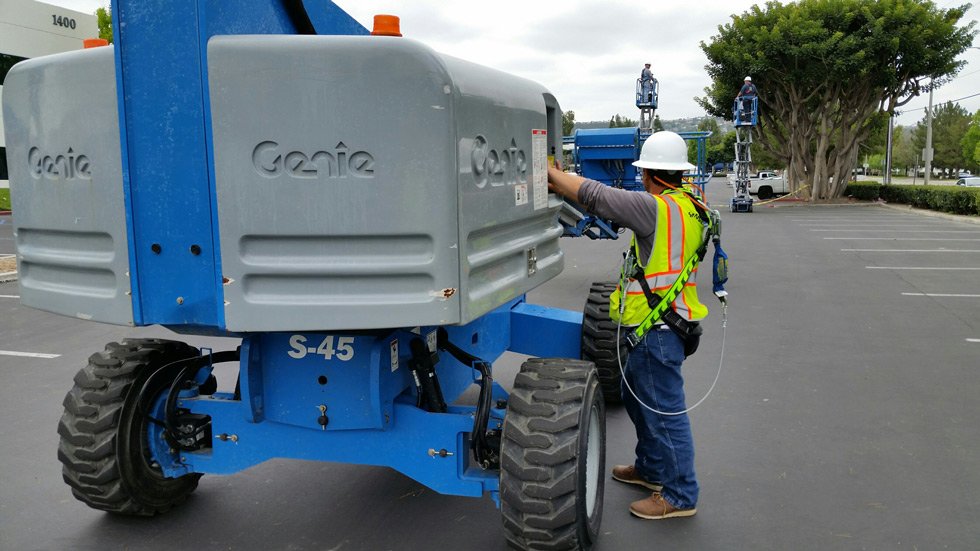OSX 949d • Trainer Course: MEWPs (Aerial Lift)
Latest News
OSX 949d • Trainer Course: Mobile Elevated Work Platforms (MEWPs)
* Schedule(s) subject to change; contact our OSHA Assistant for scheduling questions | Updated Daily
Steps to Enroll:
- Submit a copy the FRONT and BACK of your current Aerial Lift Operator Card to the OSHA Dropbox.
- If verification documentation is approved, you will receive an email from CSUDH OSHA staff confirming approval (please allow 3 business days for processing).
- Proceed to Registration: To reserve your spot in the course, click the "Add" button next to your preferred course date to add to cart, and then click the "Cart" button to proceed through the checkout process.
Need help with the online self-registration process? Visit https://csudh.edu/ccpe/registration
Cart
Notifications
Notification Details
Generally, course registration opens approximately 4 months in advance; this course will appear on this page when it is opened for registration.
Check the full CSUDH OSHA Schedule ↗️ for the entire year to see when this course may be offered again.
Note: Once you place course(s) in your shopping cart, please either follow through the checkout process and purchase your course(s), or, if you decide not to register, remove the course(s) from your cart. If you leave a course in your cart for more than 24 hours, the course could become either filled or cancelled during that time period (before your registration could be completed).
Course Description
 This course is designed to develop the skills needed to train aerial lift operators on four key concepts: proficiency demonstration, responsibility, safety and equipment familiarization. Training requirements, classification, safe operation, and adult learning techniques will be emphasized during this training.
This course is designed to develop the skills needed to train aerial lift operators on four key concepts: proficiency demonstration, responsibility, safety and equipment familiarization. Training requirements, classification, safe operation, and adult learning techniques will be emphasized during this training.
It is expected that all participants will operate a scissor lift and boom lift during the familiarization part of this training following established familiarization procedures.
Upon completion of this course, students will learn the differences between various lift trucks, how to reduce injuries to co-workers and operators, and minimize damage to property and cargo.
Learning Outcomes
- Describe OSHA and Ca/OSHA requirements for aerial lift training
- Identify national consensus standards for aerial lift training
- Identify abatement methods for common aerial lift hazards
- Demonstrate concepts pf pre-operational inspections
- Describe the process of equipment familiarization
- Describe effective principals of adult learning techniques.
CEUs: 1.5
Prerequisites: Valid Aerial Lift Operator Card
Course Length: 2 days
Recommended Materials: Pen, pencil, highlighter and writing pad.
Registration Eligibility
Students who wish to participate in OSHA–numbered courses in the online synchronous video conferencing format must have a valid physical address in OSHA's San Francisco Region (AK, AZ, CA, OR, NV, HI, ID, WA, Guam, and American Samoa), or obtain permission from their local OTIEC to attend a class outside their home region.
Other CSUDH OTIEC courses can be taken by anyone (no residency required).
System and Equipment Requirements
It is important that students review the system and equipment requirements listed below to be able to successfully take part in a CSUDH OTIEC course, whether participating in person or online via video conferencing.
In-Person System and Equipment Requirements
- A laptop with built-in camera, Wi-Fi capability
Online System and Equipment Requirements
- An internet connection – broadband wired or wireless (4G/LTE or better)
- Access to computer or laptop with built-in camera – one student per device
- OSHA 510, 511, 500 and 501 Students only:
Additional stand-alone webcam or secondary device (phone) - Built-in or external speakers/headset and microphone
Additional Student Resources